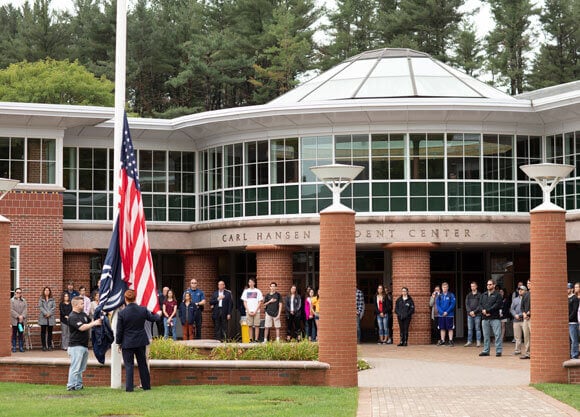Military Friendly©
Quinnipiac is recognized by Viqtory Media as being at the very top of the Best for Vets Schools in the United States.

Undergraduate Types of Aid

Undergraduate Types of Aid
At Quinnipiac, we recognize the sacrifices that current and former military service members have made on behalf of the United States. We’ve long been committed to helping our nation’s veterans, active and reserve military and National Guard members reach their educational goals. We are partnered with both the Department of Defense and Department of Veterans Affairs to provide a comprehensive set of benefits that fit with your military experience. Whether your mission is advancing your military career, transitioning to the civilian sector, or supporting your dependent as they work toward their degree, we are honored to assist you every step of the way.
Students can take AFROTC classes at Yale University’s main campus in New Haven. The first-year and sophomore courses carry no military obligation and are open to all students. After a 40-year hiatus, Yale graduated its first Air Force ROTC class in 2016; one Quinnipiac student — Catherine Perrotti— was among the graduates. Today, approximately a dozen QU students are enrolled in the Yale AFROTC program; at least half of them have a full scholarship.
Contact Air Force ROTC Detachment 009’s Admissions at (203) 432-9431.
Students can pursue a commission as an officer in the United States Regular Army, Army Reserve or Army National Guard by taking classes at the University of New Haven's campus in West Haven. No scholarships are available.
Learn more by contacting the Army ROTC Recruiting Office at 203-931-2998.
Eligible veterans of the armed forces may qualify for educational benefits. We proudly participate in the "Yellow Ribbon Program." Part of the Post 9/11 GI-Bill®, this initiative provides funds for eligible veterans who served after September 10, 2001. The Office of Veteran and Military Affairs stands ready to help you navigate all federal veterans benefits available.
Various Amounts + Match | U.S. Department of Veterans Affairs and Quinnipiac University
Military Benefit
Up to $4,500 | U.S. Department of Defense
Military Benefit
Various Amounts | U.S. Department of Veterans Affairs
Military Benefit
Various Amounts | U.S. Department of Veterans Affairs
Military Benefit
Various Amounts | U.S. Department of Veterans Affairs
Military Benefit
Various Amounts | U.S. Department of Veterans Affairs
Military Benefit
Various Amounts | U.S. Department of Veterans Affairs
Military Benefit
School of Education
In accordance with Title 38 US Code 3679(e), Quinnipiac University adopts the following additional provisions for any students using U.S. Department of Veterans Affairs (VA) Post-9/11 G.I. Bill® (Ch. 33) or Vocational Rehabilitation & Employment (Ch. 31) benefits, while payment to the institution is pending from VA. Quinnipiac University will not:
Prevent the student’s enrollment;
Assess a late penalty fee to the student;
Require the student to secure alternative or additional funding;
Deny the student access to any resources (access to classes, libraries, or other institutional facilities).
However, to qualify for this provision, such students may be required to:
Provide a written request to be certified;
Provide additional information needed to properly certify the enrollment as described in other institutional policies
GI Bill® is a registered trademark of the U.S. Department of Veterans Affairs (VA).
In addition to the benefits listed above, we encourage military families to file the FAFSA and consider other financial aid options.
Complete the FAFSA
Approximately 59% of students at Quinnipiac borrow one or more federal student loan. The U.S. Department of Education uses the Cohort Default Rate (CDR) as a measure of federal student loan repayment at post-secondary institutions. The CDR represents the percentage of borrowers who entered repayment at a point in time, then defaulted (failed to make payments) on their loan within a three year period.
The last three official CDR for students entering repayment of their Federal Student Loans at Quinnipiac University are:
2.6% for the 2017 fiscal year (national average for the same time period was 9.7%)
2.3% for the 2018 fiscal year (national average for the same time period was 7.3%)
1.2% for the 2019 fiscal year (national average for the same time period was 2.3%)
Explore your financial aid opportunities
Scholarships and Grants
Loans
Work Opportunities and Stipends
Awards and Benefits
More Resources
We‘re here to help provide additional information and answer your questions about the financial aid process.